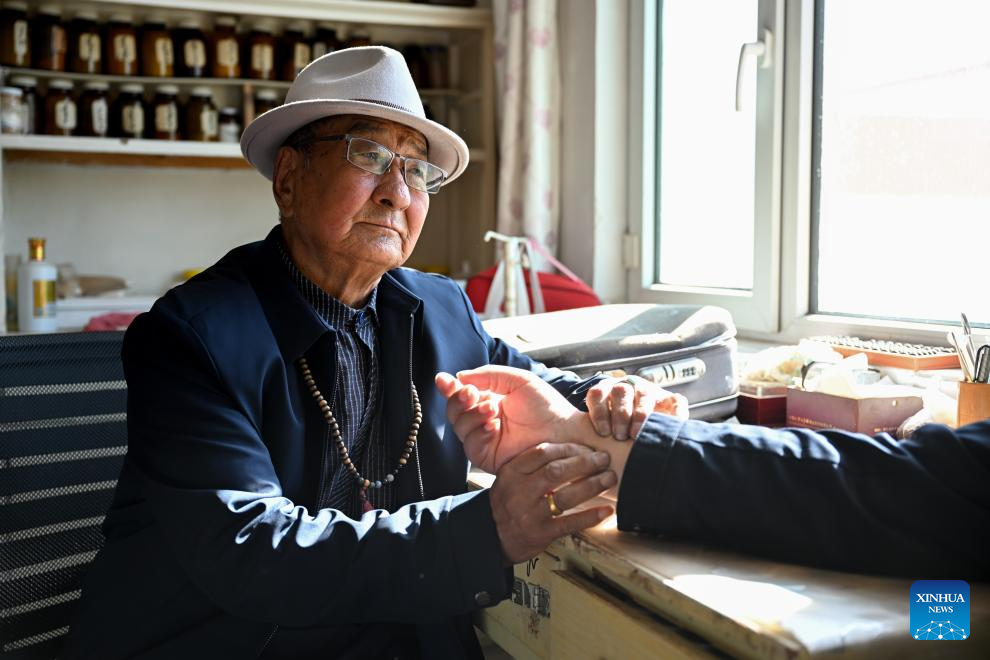
Mingan-erdeni feels the pulse of a herdsman at his home in Otog Banner of Ordos, north China's Inner Mongolia Autonomous Region, Oct. 16, 2023.
Dorji is a 61-year-old herdsman living in Otog Banner. During the autumn season, Dorji's daily routine includes herding horses and goats. He has over 200 Arabas cashmere goats, which provide sound economic returns.
In his spare time, Dorji participates in a local cultural activity called "Nair" with his 91-year-old father, Mingan-erdeni. "Nair" dates back to the Yuan Dynasty (1271-1368) and is a form of folk art that involves playing musical instruments, singing, and dancing. It has been listed as a regional intangible cultural heritage in Inner Mongolia.
Mingan-erdeni, a former rural doctor, encouraged his neighbors to form a "Nair" band in 2018. This band not only represents the preservation of the "Nair" culture but also serves as an important means to enrich the spiritual life of these senior herdsmen. Harvesting and music together make up the autumn life of Dorji and many other herdsmen in Ordos. (Xinhua/Bei He)
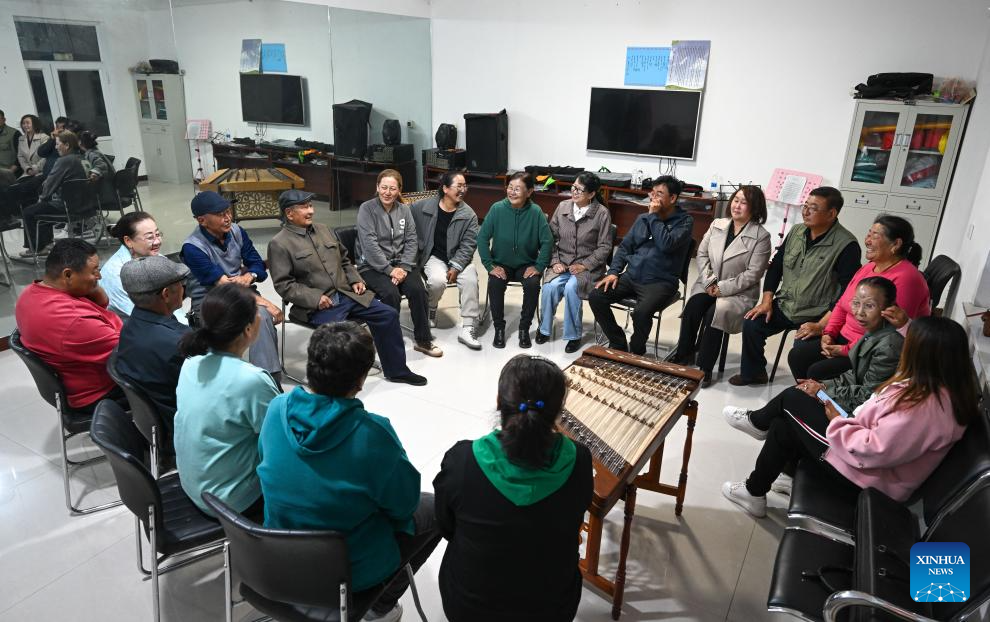
Members of a "Nair" band gather in an activity room in Otog Banner of Ordos, north China's Inner Mongolia Autonomous Region, Oct. 15, 2023.
Dorji is a 61-year-old herdsman living in Otog Banner. During the autumn season, Dorji's daily routine includes herding horses and goats. He has over 200 Arabas cashmere goats, which provide sound economic returns.
In his spare time, Dorji participates in a local cultural activity called "Nair" with his 91-year-old father, Mingan-erdeni. "Nair" dates back to the Yuan Dynasty (1271-1368) and is a form of folk art that involves playing musical instruments, singing, and dancing. It has been listed as a regional intangible cultural heritage in Inner Mongolia.
Mingan-erdeni, a former rural doctor, encouraged his neighbors to form a "Nair" band in 2018. This band not only represents the preservation of the "Nair" culture but also serves as an important means to enrich the spiritual life of these senior herdsmen. Harvesting and music together make up the autumn life of Dorji and many other herdsmen in Ordos. (Xinhua/Bei He)

Mingan-erdeni (2nd L) and his fellow "Nair" band members are seen during a rehearsal in Otog Banner of Ordos, north China's Inner Mongolia Autonomous Region, Oct. 15, 2023.
Dorji is a 61-year-old herdsman living in Otog Banner. During the autumn season, Dorji's daily routine includes herding horses and goats. He has over 200 Arabas cashmere goats, which provide sound economic returns.
In his spare time, Dorji participates in a local cultural activity called "Nair" with his 91-year-old father, Mingan-erdeni. "Nair" dates back to the Yuan Dynasty (1271-1368) and is a form of folk art that involves playing musical instruments, singing, and dancing. It has been listed as a regional intangible cultural heritage in Inner Mongolia.
Mingan-erdeni, a former rural doctor, encouraged his neighbors to form a "Nair" band in 2018. This band not only represents the preservation of the "Nair" culture but also serves as an important means to enrich the spiritual life of these senior herdsmen. Harvesting and music together make up the autumn life of Dorji and many other herdsmen in Ordos. (Xinhua/Bei He)
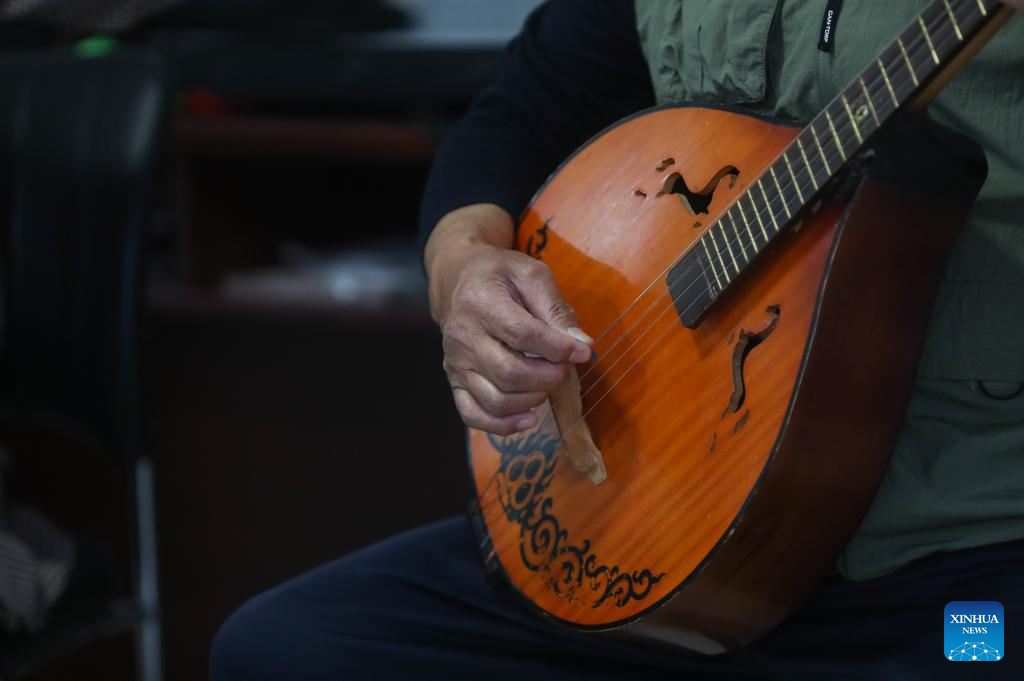
Dorji plays music in Otog Banner of Ordos, north China's Inner Mongolia Autonomous Region, Oct. 15, 2023.
Dorji is a 61-year-old herdsman living in Otog Banner. During the autumn season, Dorji's daily routine includes herding horses and goats. He has over 200 Arabas cashmere goats, which provide sound economic returns.
In his spare time, Dorji participates in a local cultural activity called "Nair" with his 91-year-old father, Mingan-erdeni. "Nair" dates back to the Yuan Dynasty (1271-1368) and is a form of folk art that involves playing musical instruments, singing, and dancing. It has been listed as a regional intangible cultural heritage in Inner Mongolia.
Mingan-erdeni, a former rural doctor, encouraged his neighbors to form a "Nair" band in 2018. This band not only represents the preservation of the "Nair" culture but also serves as an important means to enrich the spiritual life of these senior herdsmen. Harvesting and music together make up the autumn life of Dorji and many other herdsmen in Ordos. (Xinhua/Wang Kaiyan)
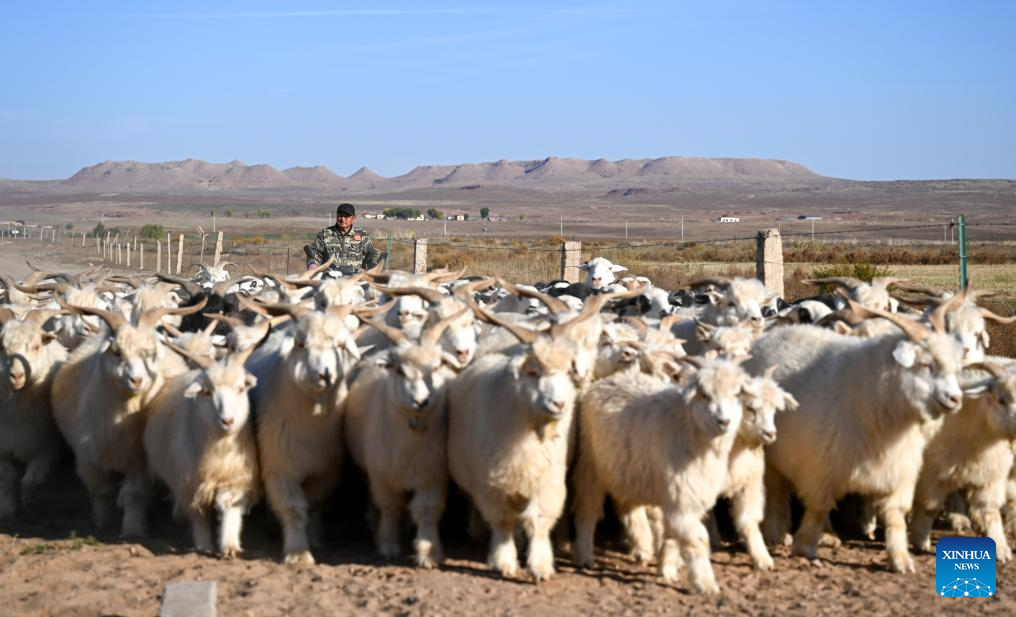
Dorji herds his goats on a grassland in Otog Banner of Ordos, north China's Inner Mongolia Autonomous Region, Oct. 16, 2023.
Dorji is a 61-year-old herdsman living in Otog Banner. During the autumn season, Dorji's daily routine includes herding horses and goats. He has over 200 Arabas cashmere goats, which provide sound economic returns.
In his spare time, Dorji participates in a local cultural activity called "Nair" with his 91-year-old father, Mingan-erdeni. "Nair" dates back to the Yuan Dynasty (1271-1368) and is a form of folk art that involves playing musical instruments, singing, and dancing. It has been listed as a regional intangible cultural heritage in Inner Mongolia.
Mingan-erdeni, a former rural doctor, encouraged his neighbors to form a "Nair" band in 2018. This band not only represents the preservation of the "Nair" culture but also serves as an important means to enrich the spiritual life of these senior herdsmen. Harvesting and music together make up the autumn life of Dorji and many other herdsmen in Ordos. (Xinhua/Bei He)
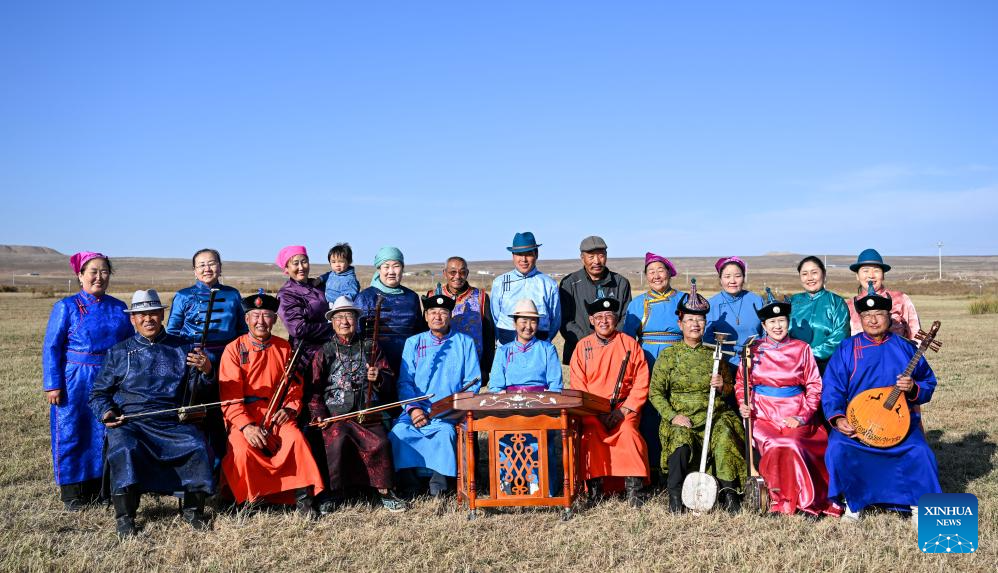
Members of a "Nair" band pose for group photos on a grassland in Otog Banner of Ordos, north China's Inner Mongolia Autonomous Region, Oct. 16, 2023.
Dorji is a 61-year-old herdsman living in Otog Banner. During the autumn season, Dorji's daily routine includes herding horses and goats. He has over 200 Arabas cashmere goats, which provide sound economic returns.
In his spare time, Dorji participates in a local cultural activity called "Nair" with his 91-year-old father, Mingan-erdeni. "Nair" dates back to the Yuan Dynasty (1271-1368) and is a form of folk art that involves playing musical instruments, singing, and dancing. It has been listed as a regional intangible cultural heritage in Inner Mongolia.
Mingan-erdeni, a former rural doctor, encouraged his neighbors to form a "Nair" band in 2018. This band not only represents the preservation of the "Nair" culture but also serves as an important means to enrich the spiritual life of these senior herdsmen. Harvesting and music together make up the autumn life of Dorji and many other herdsmen in Ordos. (Xinhua/Bei He)
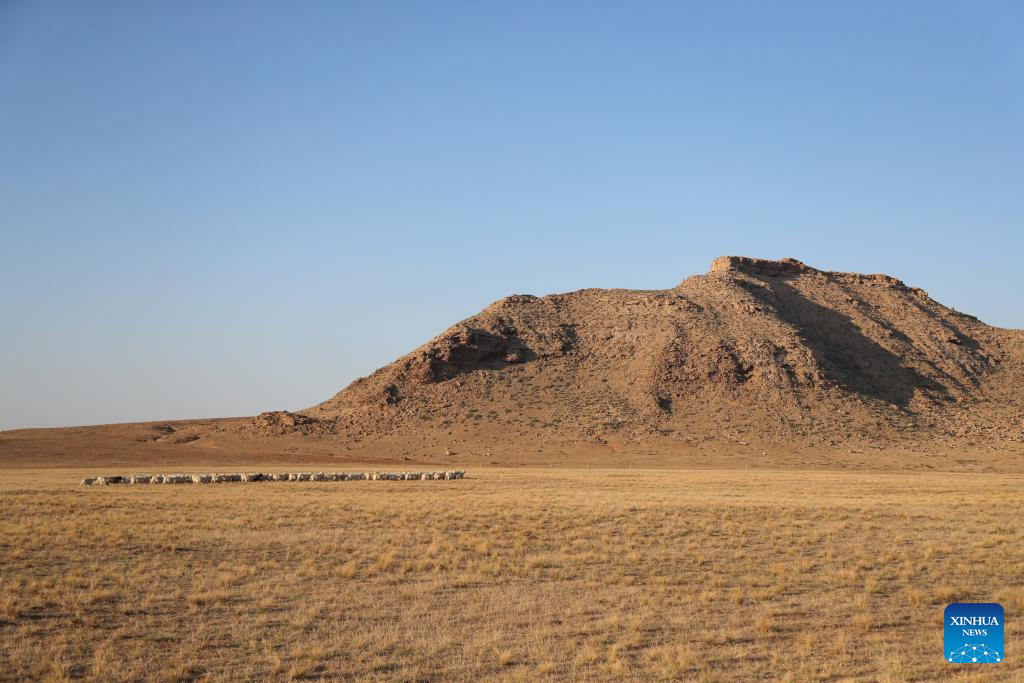
This photo taken on Oct. 15, 2023 shows the autumn scenery of grasslands in Ordos, north China's Inner Mongolia Autonomous Region.
Dorji is a 61-year-old herdsman living in Otog Banner. During the autumn season, Dorji's daily routine includes herding horses and goats. He has over 200 Arabas cashmere goats, which provide sound economic returns.
In his spare time, Dorji participates in a local cultural activity called "Nair" with his 91-year-old father, Mingan-erdeni. "Nair" dates back to the Yuan Dynasty (1271-1368) and is a form of folk art that involves playing musical instruments, singing, and dancing. It has been listed as a regional intangible cultural heritage in Inner Mongolia.
Mingan-erdeni, a former rural doctor, encouraged his neighbors to form a "Nair" band in 2018. This band not only represents the preservation of the "Nair" culture but also serves as an important means to enrich the spiritual life of these senior herdsmen. Harvesting and music together make up the autumn life of Dorji and many other herdsmen in Ordos. (Xinhua/Wang Kaiyan)
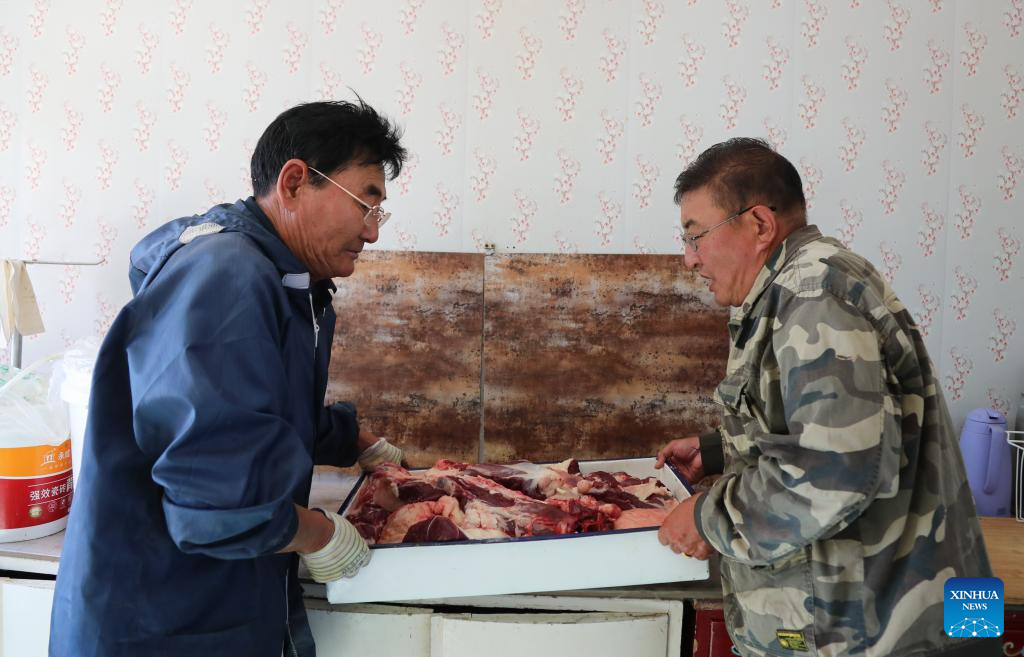
Dorji (R) carries a plate of mutton for storage with his friend in Otog Banner of Ordos, north China's Inner Mongolia Autonomous Region, Oct. 16, 2023.
Dorji is a 61-year-old herdsman living in Otog Banner. During the autumn season, Dorji's daily routine includes herding horses and goats. He has over 200 Arabas cashmere goats, which provide sound economic returns.
In his spare time, Dorji participates in a local cultural activity called "Nair" with his 91-year-old father, Mingan-erdeni. "Nair" dates back to the Yuan Dynasty (1271-1368) and is a form of folk art that involves playing musical instruments, singing, and dancing. It has been listed as a regional intangible cultural heritage in Inner Mongolia.
Mingan-erdeni, a former rural doctor, encouraged his neighbors to form a "Nair" band in 2018. This band not only represents the preservation of the "Nair" culture but also serves as an important means to enrich the spiritual life of these senior herdsmen. Harvesting and music together make up the autumn life of Dorji and many other herdsmen in Ordos. (Xinhua/Wang Kaiyan)

Mingan-erdeni kisses one of his horses in Otog Banner of Ordos, north China's Inner Mongolia Autonomous Region, Oct. 16, 2023.
Dorji is a 61-year-old herdsman living in Otog Banner. During the autumn season, Dorji's daily routine includes herding horses and goats. He has over 200 Arabas cashmere goats, which provide sound economic returns.
In his spare time, Dorji participates in a local cultural activity called "Nair" with his 91-year-old father, Mingan-erdeni. "Nair" dates back to the Yuan Dynasty (1271-1368) and is a form of folk art that involves playing musical instruments, singing, and dancing. It has been listed as a regional intangible cultural heritage in Inner Mongolia.
Mingan-erdeni, a former rural doctor, encouraged his neighbors to form a "Nair" band in 2018. This band not only represents the preservation of the "Nair" culture but also serves as an important means to enrich the spiritual life of these senior herdsmen. Harvesting and music together make up the autumn life of Dorji and many other herdsmen in Ordos. (Xinhua/Wang Kaiyan)
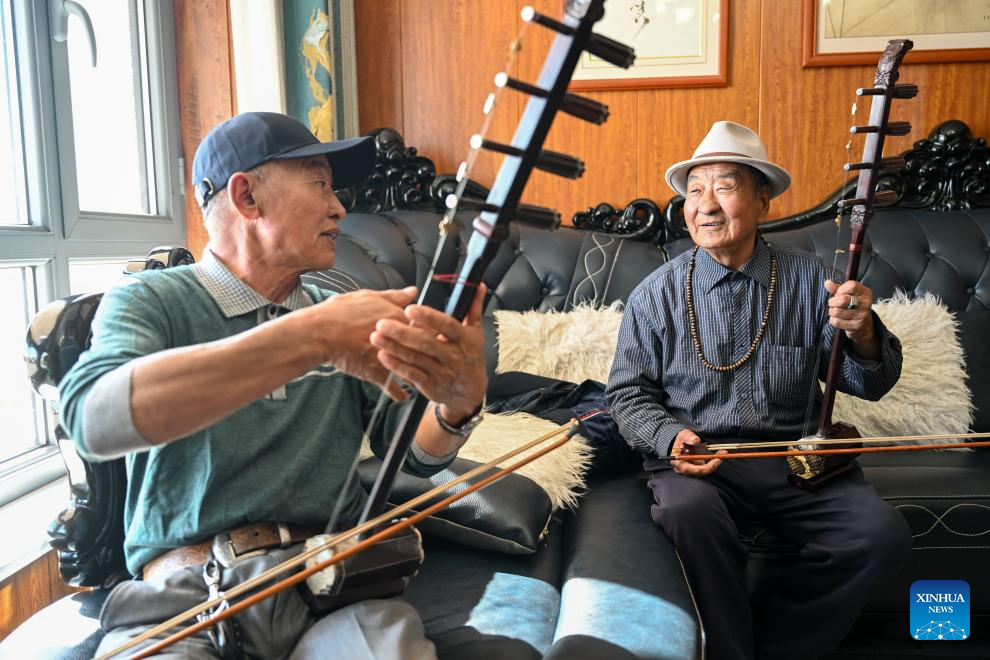
Mingan-erdeni (R) talks with a "Nair" band member at home in Otog Banner of Ordos, north China's Inner Mongolia Autonomous Region, Oct. 16, 2023.
Dorji is a 61-year-old herdsman living in Otog Banner. During the autumn season, Dorji's daily routine includes herding horses and goats. He has over 200 Arabas cashmere goats, which provide sound economic returns.
In his spare time, Dorji participates in a local cultural activity called "Nair" with his 91-year-old father, Mingan-erdeni. "Nair" dates back to the Yuan Dynasty (1271-1368) and is a form of folk art that involves playing musical instruments, singing, and dancing. It has been listed as a regional intangible cultural heritage in Inner Mongolia.
Mingan-erdeni, a former rural doctor, encouraged his neighbors to form a "Nair" band in 2018. This band not only represents the preservation of the "Nair" culture but also serves as an important means to enrich the spiritual life of these senior herdsmen. Harvesting and music together make up the autumn life of Dorji and many other herdsmen in Ordos. (Xinhua/Bei He)
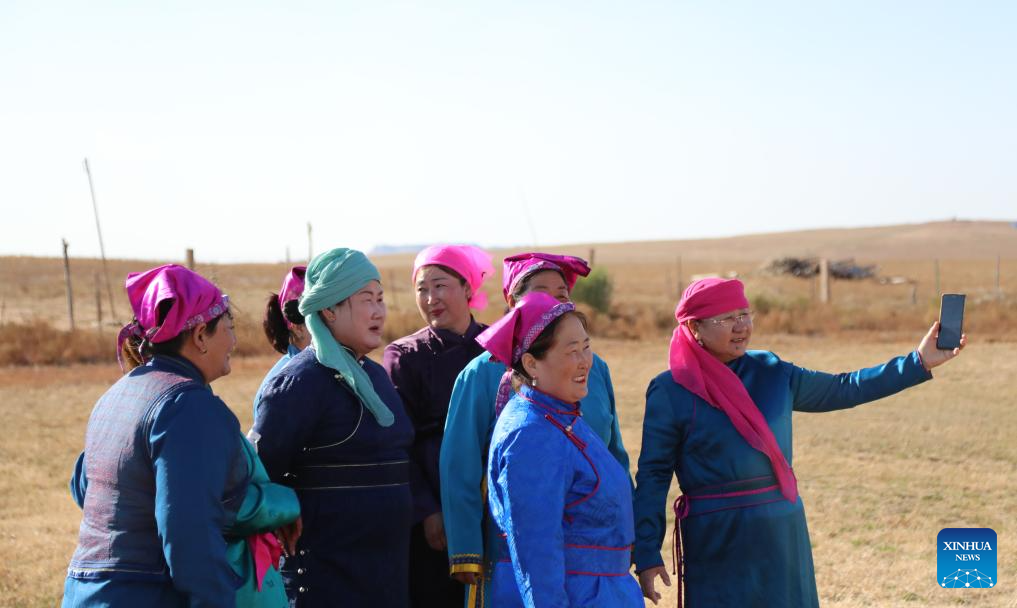
Members of a "Nair" band prepare to take group photos during the intervals of performing on a grassland in Otog Banner of Ordos, north China's Inner Mongolia Autonomous Region, Oct. 16, 2023.
Dorji is a 61-year-old herdsman living in Otog Banner. During the autumn season, Dorji's daily routine includes herding horses and goats. He has over 200 Arabas cashmere goats, which provide sound economic returns.
In his spare time, Dorji participates in a local cultural activity called "Nair" with his 91-year-old father, Mingan-erdeni. "Nair" dates back to the Yuan Dynasty (1271-1368) and is a form of folk art that involves playing musical instruments, singing, and dancing. It has been listed as a regional intangible cultural heritage in Inner Mongolia.
Mingan-erdeni, a former rural doctor, encouraged his neighbors to form a "Nair" band in 2018. This band not only represents the preservation of the "Nair" culture but also serves as an important means to enrich the spiritual life of these senior herdsmen. Harvesting and music together make up the autumn life of Dorji and many other herdsmen in Ordos. (Xinhua/Wang Kaiyan)
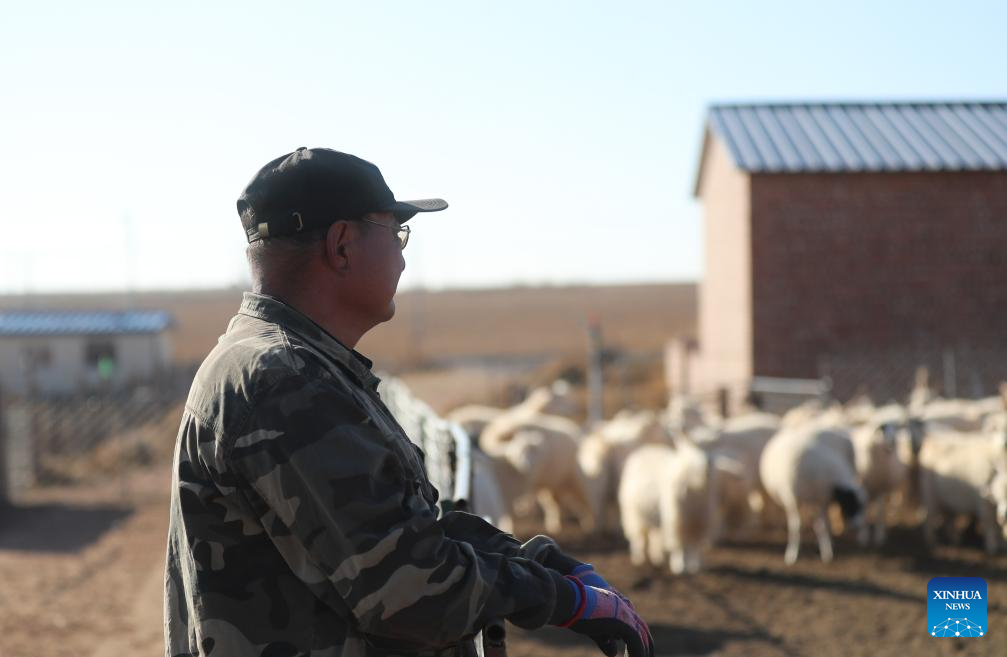
Dorji looks at his goats in Otog Banner of Ordos, north China's Inner Mongolia Autonomous Region, Oct. 16, 2023.
Dorji is a 61-year-old herdsman living in Otog Banner. During the autumn season, Dorji's daily routine includes herding horses and goats. He has over 200 Arabas cashmere goats, which provide sound economic returns.
In his spare time, Dorji participates in a local cultural activity called "Nair" with his 91-year-old father, Mingan-erdeni. "Nair" dates back to the Yuan Dynasty (1271-1368) and is a form of folk art that involves playing musical instruments, singing, and dancing. It has been listed as a regional intangible cultural heritage in Inner Mongolia.
Mingan-erdeni, a former rural doctor, encouraged his neighbors to form a "Nair" band in 2018. This band not only represents the preservation of the "Nair" culture but also serves as an important means to enrich the spiritual life of these senior herdsmen. Harvesting and music together make up the autumn life of Dorji and many other herdsmen in Ordos. (Xinhua/Wang Kaiyan)
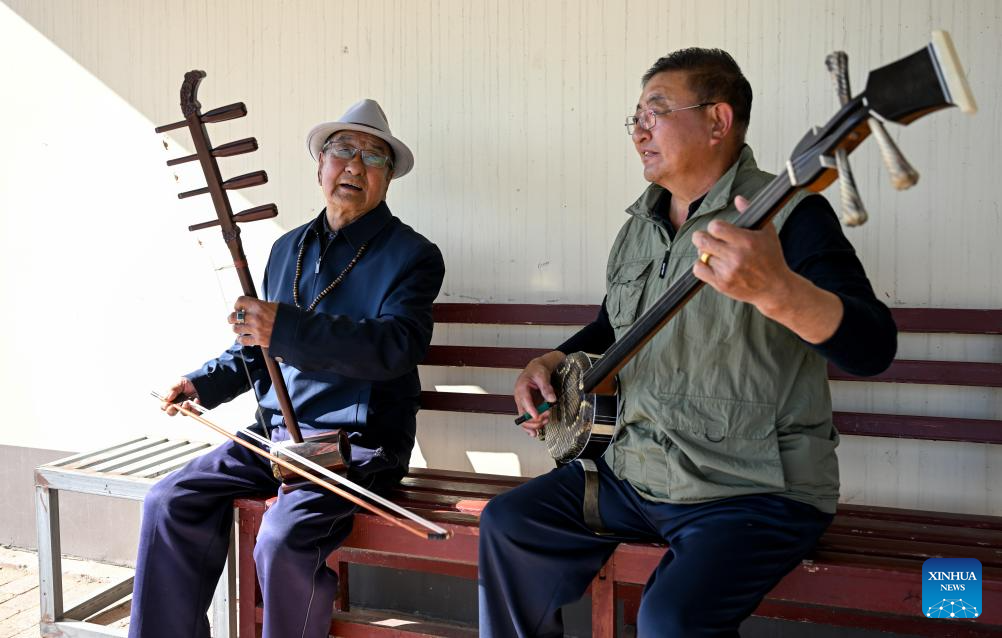
Dorji (R) and his father Mingan-erdeni play music in their courtyard in Otog Banner of Ordos, north China's Inner Mongolia Autonomous Region, Oct. 16, 2023.
Dorji is a 61-year-old herdsman living in Otog Banner. During the autumn season, Dorji's daily routine includes herding horses and goats. He has over 200 Arabas cashmere goats, which provide sound economic returns.
In his spare time, Dorji participates in a local cultural activity called "Nair" with his 91-year-old father, Mingan-erdeni. "Nair" dates back to the Yuan Dynasty (1271-1368) and is a form of folk art that involves playing musical instruments, singing, and dancing. It has been listed as a regional intangible cultural heritage in Inner Mongolia.
Mingan-erdeni, a former rural doctor, encouraged his neighbors to form a "Nair" band in 2018. This band not only represents the preservation of the "Nair" culture but also serves as an important means to enrich the spiritual life of these senior herdsmen. Harvesting and music together make up the autumn life of Dorji and many other herdsmen in Ordos. (Xinhua/Bei He)

This aerial photo taken on Oct. 16, 2023 shows a "Nair" band performing on a grassland in Otog Banner of Ordos, north China's Inner Mongolia Autonomous Region.
Dorji is a 61-year-old herdsman living in Otog Banner. During the autumn season, Dorji's daily routine includes herding horses and goats. He has over 200 Arabas cashmere goats, which provide sound economic returns.
In his spare time, Dorji participates in a local cultural activity called "Nair" with his 91-year-old father, Mingan-erdeni. "Nair" dates back to the Yuan Dynasty (1271-1368) and is a form of folk art that involves playing musical instruments, singing, and dancing. It has been listed as a regional intangible cultural heritage in Inner Mongolia.
Mingan-erdeni, a former rural doctor, encouraged his neighbors to form a "Nair" band in 2018. This band not only represents the preservation of the "Nair" culture but also serves as an important means to enrich the spiritual life of these senior herdsmen. Harvesting and music together make up the autumn life of Dorji and many other herdsmen in Ordos. (Xinhua/Bei He)
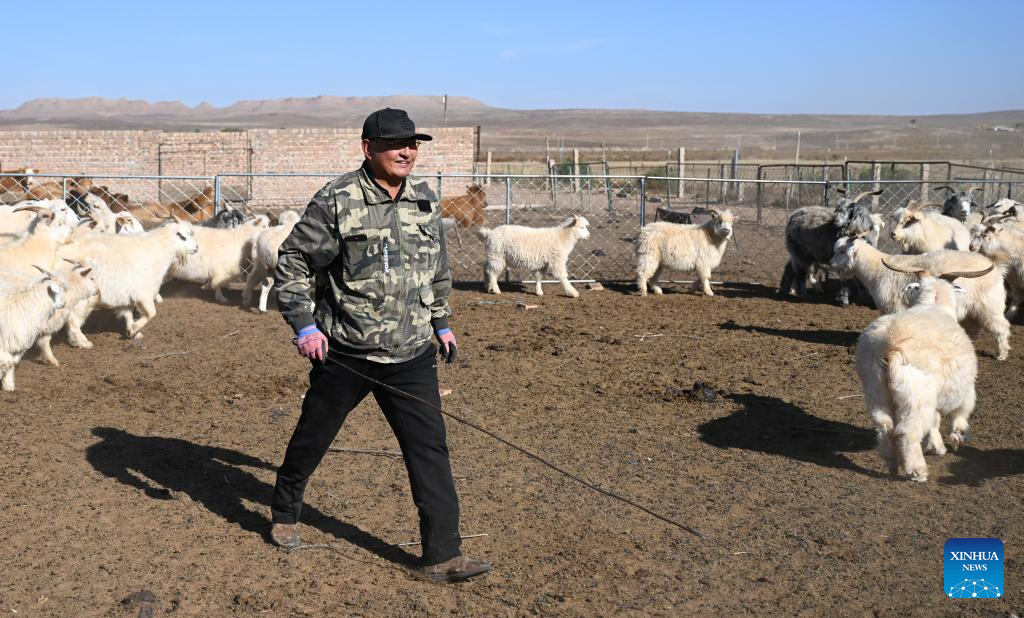
Dorji prepares to catch a goat to treat his visiting friends in Otog Banner of Ordos, north China's Inner Mongolia Autonomous Region, Oct. 16, 2023.
Dorji is a 61-year-old herdsman living in Otog Banner. During the autumn season, Dorji's daily routine includes herding horses and goats. He has over 200 Arabas cashmere goats, which provide sound economic returns.
In his spare time, Dorji participates in a local cultural activity called "Nair" with his 91-year-old father, Mingan-erdeni. "Nair" dates back to the Yuan Dynasty (1271-1368) and is a form of folk art that involves playing musical instruments, singing, and dancing. It has been listed as a regional intangible cultural heritage in Inner Mongolia.
Mingan-erdeni, a former rural doctor, encouraged his neighbors to form a "Nair" band in 2018. This band not only represents the preservation of the "Nair" culture but also serves as an important means to enrich the spiritual life of these senior herdsmen. Harvesting and music together make up the autumn life of Dorji and many other herdsmen in Ordos. (Xinhua/Bei He)

Dorji checks on his goats inside his house through a monitor in Otog Banner of Ordos, north China's Inner Mongolia Autonomous Region, Oct. 16, 2023.
Dorji is a 61-year-old herdsman living in Otog Banner. During the autumn season, Dorji's daily routine includes herding horses and goats. He has over 200 Arabas cashmere goats, which provide sound economic returns.
In his spare time, Dorji participates in a local cultural activity called "Nair" with his 91-year-old father, Mingan-erdeni. "Nair" dates back to the Yuan Dynasty (1271-1368) and is a form of folk art that involves playing musical instruments, singing, and dancing. It has been listed as a regional intangible cultural heritage in Inner Mongolia.
Mingan-erdeni, a former rural doctor, encouraged his neighbors to form a "Nair" band in 2018. This band not only represents the preservation of the "Nair" culture but also serves as an important means to enrich the spiritual life of these senior herdsmen. Harvesting and music together make up the autumn life of Dorji and many other herdsmen in Ordos. (Xinhua/Wang Kaiyan)

Dorji herds horses in Otog Banner of Ordos, north China's Inner Mongolia Autonomous Region, Oct. 16, 2023.
Dorji is a 61-year-old herdsman living in Otog Banner. During the autumn season, Dorji's daily routine includes herding horses and goats. He has over 200 Arabas cashmere goats, which provide sound economic returns.
In his spare time, Dorji participates in a local cultural activity called "Nair" with his 91-year-old father, Mingan-erdeni. "Nair" dates back to the Yuan Dynasty (1271-1368) and is a form of folk art that involves playing musical instruments, singing, and dancing. It has been listed as a regional intangible cultural heritage in Inner Mongolia.
Mingan-erdeni, a former rural doctor, encouraged his neighbors to form a "Nair" band in 2018. This band not only represents the preservation of the "Nair" culture but also serves as an important means to enrich the spiritual life of these senior herdsmen. Harvesting and music together make up the autumn life of Dorji and many other herdsmen in Ordos. (Xinhua/Wang Kaiyan)

Members of a "Nair" band perform on a grassland in Otog Banner of Ordos, north China's Inner Mongolia Autonomous Region, Oct. 16, 2023.
Dorji is a 61-year-old herdsman living in Otog Banner. During the autumn season, Dorji's daily routine includes herding horses and goats. He has over 200 Arabas cashmere goats, which provide sound economic returns.
In his spare time, Dorji participates in a local cultural activity called "Nair" with his 91-year-old father, Mingan-erdeni. "Nair" dates back to the Yuan Dynasty (1271-1368) and is a form of folk art that involves playing musical instruments, singing, and dancing. It has been listed as a regional intangible cultural heritage in Inner Mongolia.
Mingan-erdeni, a former rural doctor, encouraged his neighbors to form a "Nair" band in 2018. This band not only represents the preservation of the "Nair" culture but also serves as an important means to enrich the spiritual life of these senior herdsmen. Harvesting and music together make up the autumn life of Dorji and many other herdsmen in Ordos. (Xinhua/Wang Kaiyan)

This aerial photo taken on Oct. 16, 2023 shows members of the band Nair dancing in front of Dorji's yurt in Otog Banner of Ordos, north China's Inner Mongolia Autonomous Region.
Dorji is a 61-year-old herdsman living in Otog Banner. During the autumn season, Dorji's daily routine includes herding horses and goats. He has over 200 Arabas cashmere goats, which provide sound economic returns.
In his spare time, Dorji participates in a local cultural activity called "Nair" with his 91-year-old father, Mingan-erdeni. "Nair" dates back to the Yuan Dynasty (1271-1368) and is a form of folk art that involves playing musical instruments, singing, and dancing. It has been listed as a regional intangible cultural heritage in Inner Mongolia.
Mingan-erdeni, a former rural doctor, encouraged his neighbors to form a "Nair" band in 2018. This band not only represents the preservation of the "Nair" culture but also serves as an important means to enrich the spiritual life of these senior herdsmen. Harvesting and music together make up the autumn life of Dorji and many other herdsmen in Ordos. (Xinhua/Bei He)
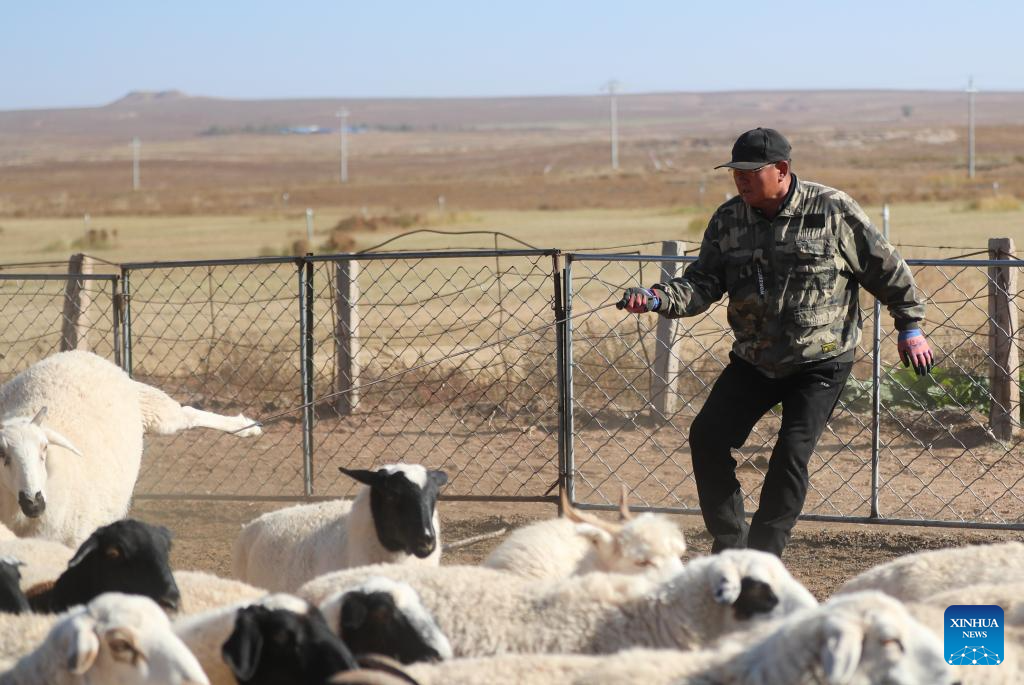
Dorji catches a goat to treat his visiting friends in Otog Banner of Ordos, north China's Inner Mongolia Autonomous Region, Oct. 16, 2023.
Dorji is a 61-year-old herdsman living in Otog Banner. During the autumn season, Dorji's daily routine includes herding horses and goats. He has over 200 Arabas cashmere goats, which provide sound economic returns.
In his spare time, Dorji participates in a local cultural activity called "Nair" with his 91-year-old father, Mingan-erdeni. "Nair" dates back to the Yuan Dynasty (1271-1368) and is a form of folk art that involves playing musical instruments, singing, and dancing. It has been listed as a regional intangible cultural heritage in Inner Mongolia.
Mingan-erdeni, a former rural doctor, encouraged his neighbors to form a "Nair" band in 2018. This band not only represents the preservation of the "Nair" culture but also serves as an important means to enrich the spiritual life of these senior herdsmen. Harvesting and music together make up the autumn life of Dorji and many other herdsmen in Ordos. (Xinhua/Wang Kaiyan)
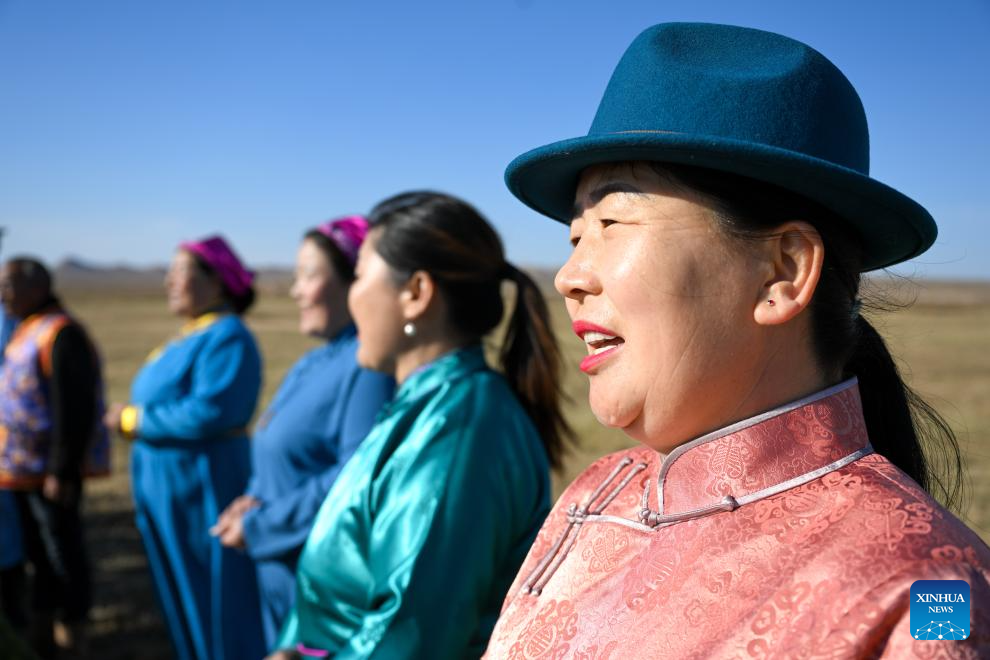
Members of a "Nair" band perform in Otog Banner of Ordos, north China's Inner Mongolia Autonomous Region, Oct. 16, 2023.
Dorji is a 61-year-old herdsman living in Otog Banner. During the autumn season, Dorji's daily routine includes herding horses and goats. He has over 200 Arabas cashmere goats, which provide sound economic returns.
In his spare time, Dorji participates in a local cultural activity called "Nair" with his 91-year-old father, Mingan-erdeni. "Nair" dates back to the Yuan Dynasty (1271-1368) and is a form of folk art that involves playing musical instruments, singing, and dancing. It has been listed as a regional intangible cultural heritage in Inner Mongolia.
Mingan-erdeni, a former rural doctor, encouraged his neighbors to form a "Nair" band in 2018. This band not only represents the preservation of the "Nair" culture but also serves as an important means to enrich the spiritual life of these senior herdsmen. Harvesting and music together make up the autumn life of Dorji and many other herdsmen in Ordos. (Xinhua/Bei He)
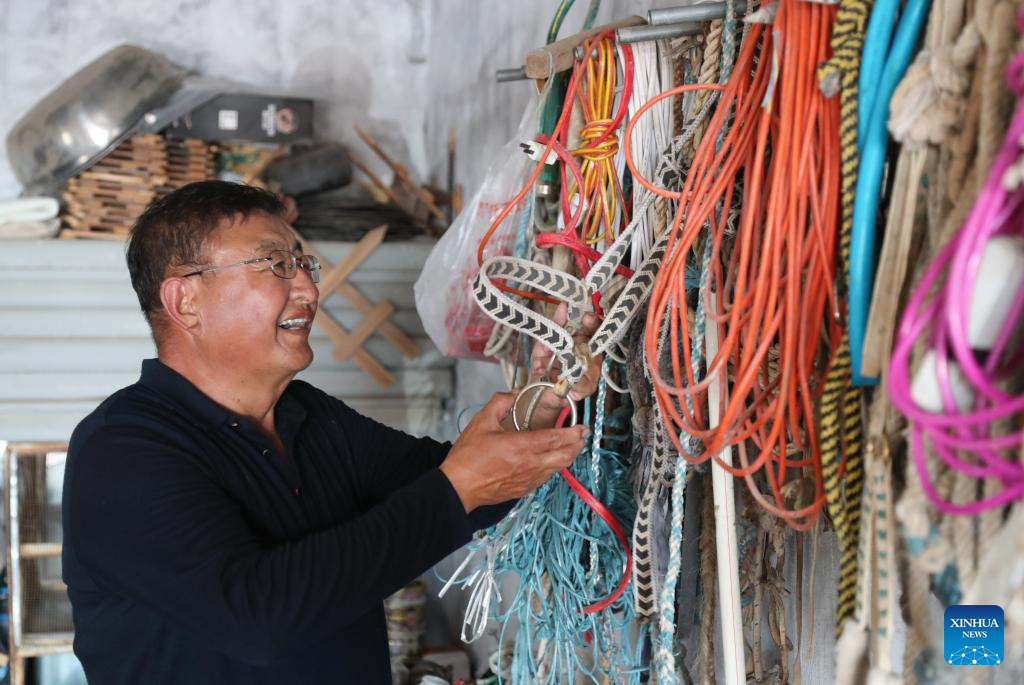
Dorji sorts out his horsing gear at home in Otog Banner of Ordos, north China's Inner Mongolia Autonomous Region, Oct. 16, 2023.
Dorji is a 61-year-old herdsman living in Otog Banner. During the autumn season, Dorji's daily routine includes herding horses and goats. He has over 200 Arabas cashmere goats, which provide sound economic returns.
In his spare time, Dorji participates in a local cultural activity called "Nair" with his 91-year-old father, Mingan-erdeni. "Nair" dates back to the Yuan Dynasty (1271-1368) and is a form of folk art that involves playing musical instruments, singing, and dancing. It has been listed as a regional intangible cultural heritage in Inner Mongolia.
Mingan-erdeni, a former rural doctor, encouraged his neighbors to form a "Nair" band in 2018. This band not only represents the preservation of the "Nair" culture but also serves as an important means to enrich the spiritual life of these senior herdsmen. Harvesting and music together make up the autumn life of Dorji and many other herdsmen in Ordos. (Xinhua/Wang Kaiyan)

Dorji (C) and his friends move a goat out of his fold in Otog Banner of Ordos, north China's Inner Mongolia Autonomous Region, Oct. 16, 2023.
Dorji is a 61-year-old herdsman living in Otog Banner. During the autumn season, Dorji's daily routine includes herding horses and goats. He has over 200 Arabas cashmere goats, which provide sound economic returns.
In his spare time, Dorji participates in a local cultural activity called "Nair" with his 91-year-old father, Mingan-erdeni. "Nair" dates back to the Yuan Dynasty (1271-1368) and is a form of folk art that involves playing musical instruments, singing, and dancing. It has been listed as a regional intangible cultural heritage in Inner Mongolia.
Mingan-erdeni, a former rural doctor, encouraged his neighbors to form a "Nair" band in 2018. This band not only represents the preservation of the "Nair" culture but also serves as an important means to enrich the spiritual life of these senior herdsmen. Harvesting and music together make up the autumn life of Dorji and many other herdsmen in Ordos. (Xinhua/Bei He)
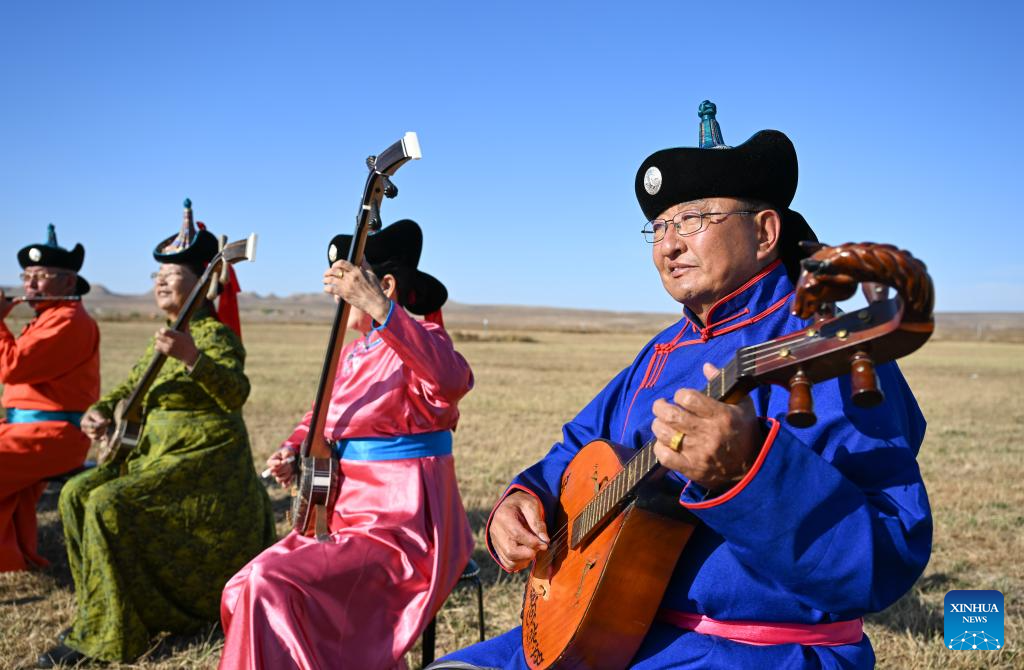
Dorji plays music during a "Nair" performance in Otog Banner of Ordos, north China's Inner Mongolia Autonomous Region, Oct. 16, 2023.
Dorji is a 61-year-old herdsman living in Otog Banner. During the autumn season, Dorji's daily routine includes herding horses and goats. He has over 200 Arabas cashmere goats, which provide sound economic returns.
In his spare time, Dorji participates in a local cultural activity called "Nair" with his 91-year-old father, Mingan-erdeni. "Nair" dates back to the Yuan Dynasty (1271-1368) and is a form of folk art that involves playing musical instruments, singing, and dancing. It has been listed as a regional intangible cultural heritage in Inner Mongolia.
Mingan-erdeni, a former rural doctor, encouraged his neighbors to form a "Nair" band in 2018. This band not only represents the preservation of the "Nair" culture but also serves as an important means to enrich the spiritual life of these senior herdsmen. Harvesting and music together make up the autumn life of Dorji and many other herdsmen in Ordos. (Xinhua/Bei He)

Dorji shoots a video of a rehearsal of a "Nair" band in Otog Banner of Ordos, north China's Inner Mongolia Autonomous Region, Oct. 15, 2023.
Dorji is a 61-year-old herdsman living in Otog Banner. During the autumn season, Dorji's daily routine includes herding horses and goats. He has over 200 Arabas cashmere goats, which provide sound economic returns.
In his spare time, Dorji participates in a local cultural activity called "Nair" with his 91-year-old father, Mingan-erdeni. "Nair" dates back to the Yuan Dynasty (1271-1368) and is a form of folk art that involves playing musical instruments, singing, and dancing. It has been listed as a regional intangible cultural heritage in Inner Mongolia.
Mingan-erdeni, a former rural doctor, encouraged his neighbors to form a "Nair" band in 2018. This band not only represents the preservation of the "Nair" culture but also serves as an important means to enrich the spiritual life of these senior herdsmen. Harvesting and music together make up the autumn life of Dorji and many other herdsmen in Ordos. (Xinhua/Wang Kaiyan)
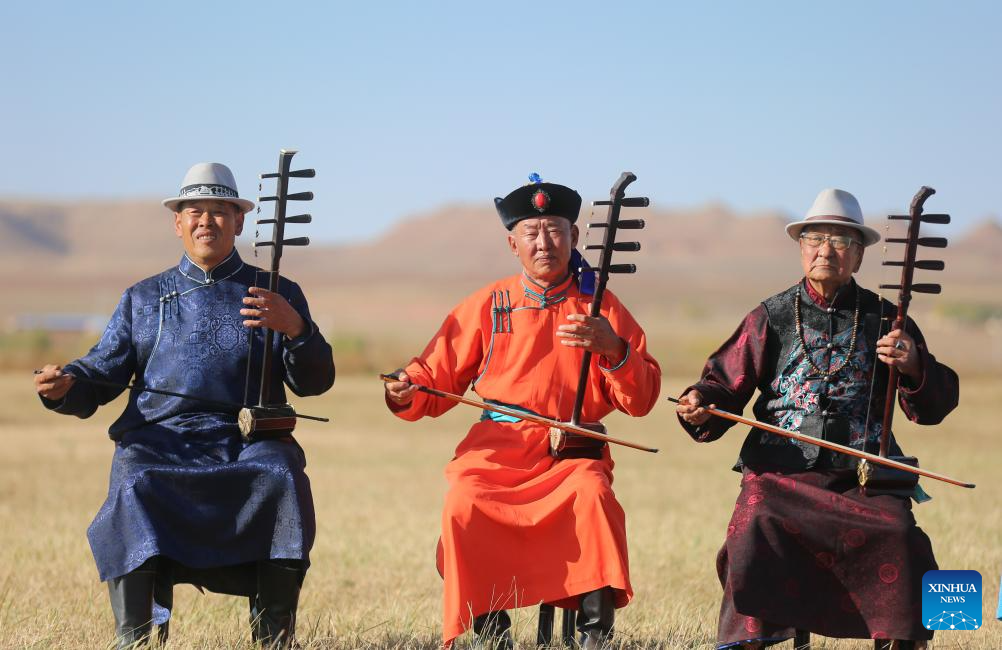
Mingan-erdeni (R) and his "Nair" band members perform in Otog Banner of Ordos, north China's Inner Mongolia Autonomous Region, Oct. 16, 2023.
Dorji is a 61-year-old herdsman living in Otog Banner. During the autumn season, Dorji's daily routine includes herding horses and goats. He has over 200 Arabas cashmere goats, which provide sound economic returns.
In his spare time, Dorji participates in a local cultural activity called "Nair" with his 91-year-old father, Mingan-erdeni. "Nair" dates back to the Yuan Dynasty (1271-1368) and is a form of folk art that involves playing musical instruments, singing, and dancing. It has been listed as a regional intangible cultural heritage in Inner Mongolia.
Mingan-erdeni, a former rural doctor, encouraged his neighbors to form a "Nair" band in 2018. This band not only represents the preservation of the "Nair" culture but also serves as an important means to enrich the spiritual life of these senior herdsmen. Harvesting and music together make up the autumn life of Dorji and many other herdsmen in Ordos. (Xinhua/Wang Kaiyan)
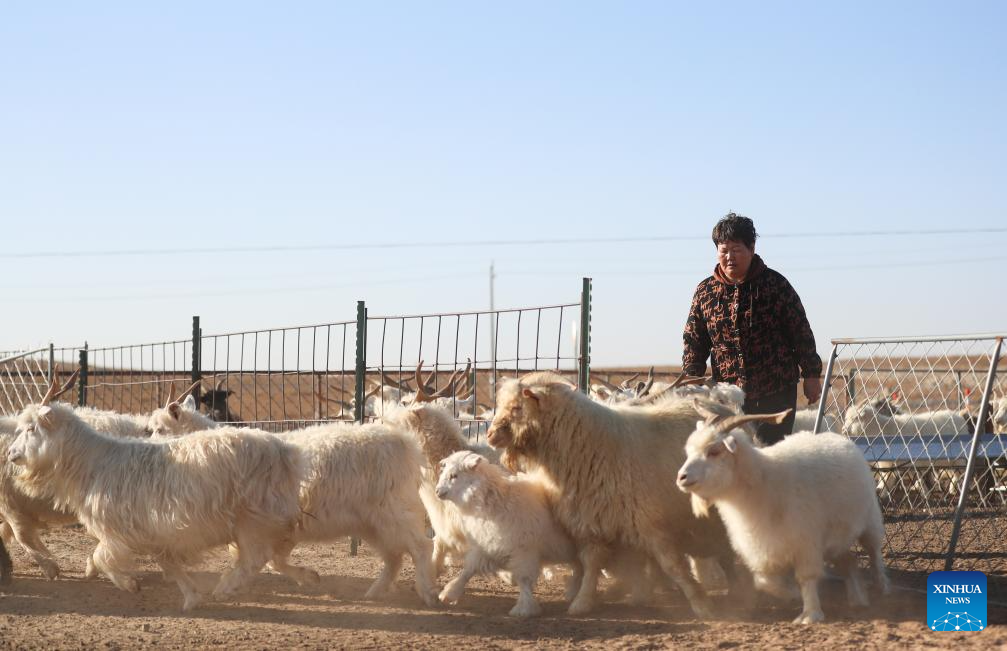
Dorji's wife Sodtsetseg herds goats in Otog Banner of Ordos, north China's Inner Mongolia Autonomous Region, Oct. 16, 2023.
Dorji is a 61-year-old herdsman living in Otog Banner. During the autumn season, Dorji's daily routine includes herding horses and goats. He has over 200 Arabas cashmere goats, which provide sound economic returns.
In his spare time, Dorji participates in a local cultural activity called "Nair" with his 91-year-old father, Mingan-erdeni. "Nair" dates back to the Yuan Dynasty (1271-1368) and is a form of folk art that involves playing musical instruments, singing, and dancing. It has been listed as a regional intangible cultural heritage in Inner Mongolia.
Mingan-erdeni, a former rural doctor, encouraged his neighbors to form a "Nair" band in 2018. This band not only represents the preservation of the "Nair" culture but also serves as an important means to enrich the spiritual life of these senior herdsmen. Harvesting and music together make up the autumn life of Dorji and many other herdsmen in Ordos. (Xinhua/Wang Kaiyan)
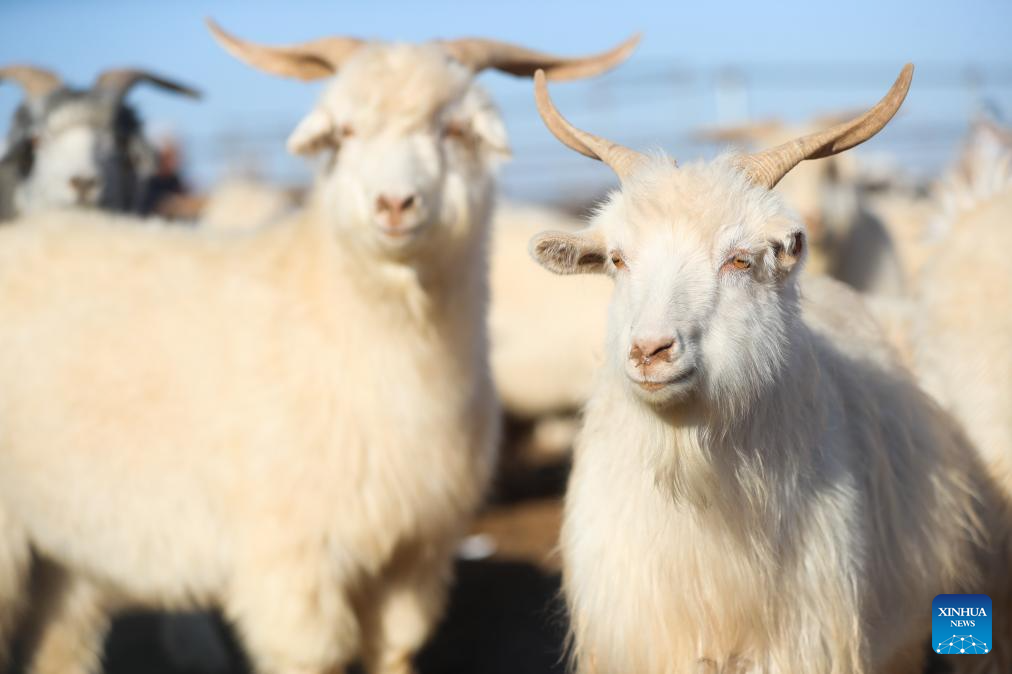
This photo taken on Oct. 16, 2023 shows Dorji's Arabas cashmere goats in Otog Banner of Ordos, north China's Inner Mongolia Autonomous Region.
Dorji is a 61-year-old herdsman living in Otog Banner. During the autumn season, Dorji's daily routine includes herding horses and goats. He has over 200 Arabas cashmere goats, which provide sound economic returns.
In his spare time, Dorji participates in a local cultural activity called "Nair" with his 91-year-old father, Mingan-erdeni. "Nair" dates back to the Yuan Dynasty (1271-1368) and is a form of folk art that involves playing musical instruments, singing, and dancing. It has been listed as a regional intangible cultural heritage in Inner Mongolia.
Mingan-erdeni, a former rural doctor, encouraged his neighbors to form a "Nair" band in 2018. This band not only represents the preservation of the "Nair" culture but also serves as an important means to enrich the spiritual life of these senior herdsmen. Harvesting and music together make up the autumn life of Dorji and many other herdsmen in Ordos. (Xinhua/Wang Kaiyan)
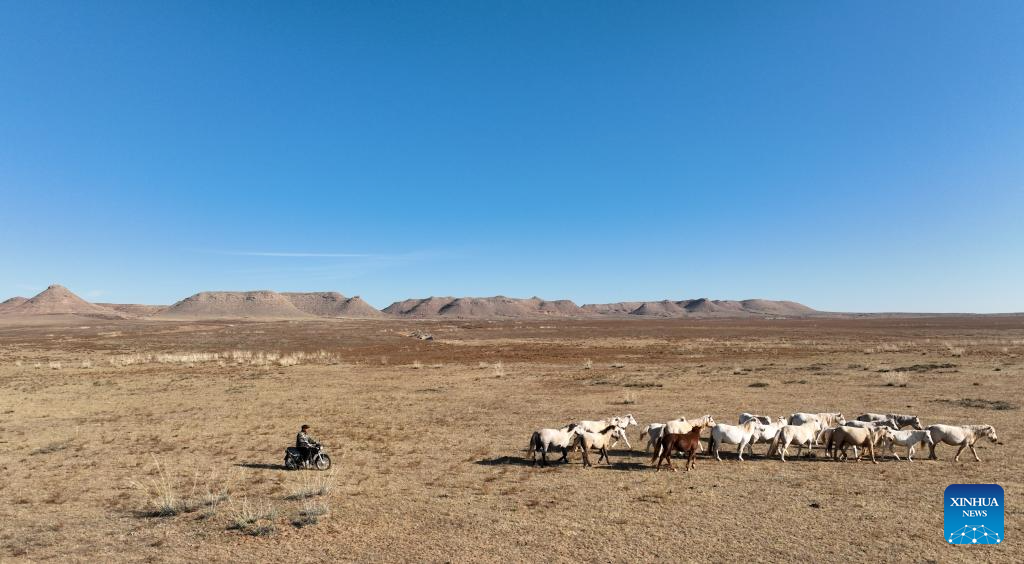
This aerial photo taken on Oct. 16, 2023 shows Dorji herding horses in Otog Banner of Ordos, north China's Inner Mongolia Autonomous Region.
Dorji is a 61-year-old herdsman living in Otog Banner. During the autumn season, Dorji's daily routine includes herding horses and goats. He has over 200 Arabas cashmere goats, which provide sound economic returns.
In his spare time, Dorji participates in a local cultural activity called "Nair" with his 91-year-old father, Mingan-erdeni. "Nair" dates back to the Yuan Dynasty (1271-1368) and is a form of folk art that involves playing musical instruments, singing, and dancing. It has been listed as a regional intangible cultural heritage in Inner Mongolia.
Mingan-erdeni, a former rural doctor, encouraged his neighbors to form a "Nair" band in 2018. This band not only represents the preservation of the "Nair" culture but also serves as an important means to enrich the spiritual life of these senior herdsmen. Harvesting and music together make up the autumn life of Dorji and many other herdsmen in Ordos. (Xinhua/Bei He)

This aerial photo taken on Oct. 15, 2023 shows the autumn scenery of grasslands in Ordos, north China's Inner Mongolia Autonomous Region.
Dorji is a 61-year-old herdsman living in Otog Banner. During the autumn season, Dorji's daily routine includes herding horses and goats. He has over 200 Arabas cashmere goats, which provide sound economic returns.
In his spare time, Dorji participates in a local cultural activity called "Nair" with his 91-year-old father, Mingan-erdeni. "Nair" dates back to the Yuan Dynasty (1271-1368) and is a form of folk art that involves playing musical instruments, singing, and dancing. It has been listed as a regional intangible cultural heritage in Inner Mongolia.
Mingan-erdeni, a former rural doctor, encouraged his neighbors to form a "Nair" band in 2018. This band not only represents the preservation of the "Nair" culture but also serves as an important means to enrich the spiritual life of these senior herdsmen. Harvesting and music together make up the autumn life of Dorji and many other herdsmen in Ordos. (Xinhua/Bei He)



